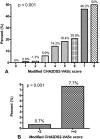Association between modified CHA2DS2-VASc Score with Ankle-Brachial index < 0.9
- PMID: 29352195
- PMCID: PMC5775199
- DOI: 10.1038/s41598-018-19243-y
Association between modified CHA2DS2-VASc Score with Ankle-Brachial index < 0.9
Abstract
The ankle-brachial index (ABI) is a reliable diagnostic examination for peripheral arterial occlusive disease (PAOD). We previously reported CHADS2 score was significantly correlated with PAOD. However, the association between CHA2DS2-VASc score and ABI < 0.9 is not evaluated in the literature. The aim of the present study was to investigate whether CHA2DS2-VASc score has a strong association with PAOD. We enrolled 1482 patients in this study. PAOD was defined as ABI < 0.9 in either leg. Vascular disease in CHA2DS2-VASc score was modified as vascular disease except PAOD. Of the 1482 subjects, the prevalence of ABI < 0.9 was 5.6%. Multivariate analysis showed that the increased age, decreased estimated glomerular filtration rate and increased modified CHA2DS2-VASc score (OR, 1.764; p < 0.001) were independent associated with ABI < 0.9. In addition, the percentage of ABI < 0.9 in patients with modified CHA2DS2-VASc score of 0, 1, and <2 were 0%, 0.9%, and 0.7%, respectively (All < 1%). Our study demonstrated modified CHA2DS2-VASc score was significantly associated with ABI < 0.9. Calculation of modified CHA2DS2-VASc score might be useful in identifying patients with PAOD and in stratifying the risk of PAOD in non-AF patients.
Conflict of interest statement
The authors declare that they have no competing interests.
Figures
References
-
- Hanssen NM, et al. Associations between the ankle-brachial index and cardiovascular and all-cause mortality are similar in individuals without and with type 2 diabetes: nineteen-year follow-up of a population-based cohort study. Diabetes Care. 2012;35:1731–1735. doi: 10.2337/dc12-0178. - DOI - PMC - PubMed
Publication types
MeSH terms
Substances
LinkOut - more resources
Full Text Sources
Other Literature Sources
Medical


